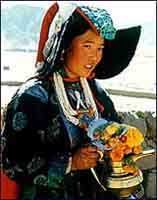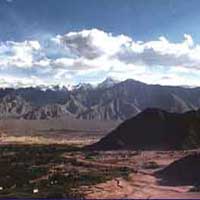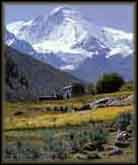| Destinations
|
|||
The itinerary of the average tourist to Ladakh begins with a tour of Leh, the ancient capital and principal township of Ladakh. It invariably includes visits to a selection of monasteries located along a stretch of the Central Indus Valley, between the spectacular monastery of Lamayuru in the west and the prestigious establishment of Hemis in the east. Some take to trekking along the lateral valleys, especially in Markha, but few venture out of the confines of the Central Indus Valley which represents Ladakh's heartland.
However, during the last decade a gradual change in the tourist's perception of Ladakh has come about, thanks to the growing mystique of the Himalayas and a burgeoning interest in adventure tourism worldwide. As a result of this change in perception there has been a steady increase in the number of tourists to the Western flank of Ladakh which comprises several river valleys. Chief among these are the spectacular valleys of Suru and Zanskar, nestling along the foothills of the main range of the Greater Himalayas; the smaller lateral valleys of Drass and Wakha-Mulbek, as also of Chiktan (still in the restricted zone) constitute important subsidiaries. Drained and formed by the southeastern tributories of the high Indus, these valleys constitute the district of Kargil. |
More on Ladakh • Overview • Zanskar • Drass • Kargil • Suru Valley • Mountaineering • Ladakhis Travelogues • Kashmir • Journey to Ladakh
Adventure |
||
 This region once formed part of the erstwhile Kingdom of Ladakh. In fact, it is believed to have been the first region to be inhabited by the early colonizers of Ladakh - the Indo-Aryan Mons from across the Himalayan range, the Darads from athe extreme western Himalayas, and the itinerant nomads from the Tibetan highlands. Also, its valleys, by virtue of their contiguity with Kashmir, Kishtwar and Kulu, served as the initial receptacles of successive ethnic and cultural waves emanating from across the Great Himalayan range. Thus, while the Mons are believed to have carried north-Indian Budhism to these highland valleys, the Darads and Baltis of the lower Indus Valley are credited with the introduction of farming and the Tibetans with the tradition of herding. The settlements that evolved as a result of intermixing of these elements-ethnic, occupational and cultural-now serve at home to a syncretic micro-society of J&K State.
This region once formed part of the erstwhile Kingdom of Ladakh. In fact, it is believed to have been the first region to be inhabited by the early colonizers of Ladakh - the Indo-Aryan Mons from across the Himalayan range, the Darads from athe extreme western Himalayas, and the itinerant nomads from the Tibetan highlands. Also, its valleys, by virtue of their contiguity with Kashmir, Kishtwar and Kulu, served as the initial receptacles of successive ethnic and cultural waves emanating from across the Great Himalayan range. Thus, while the Mons are believed to have carried north-Indian Budhism to these highland valleys, the Darads and Baltis of the lower Indus Valley are credited with the introduction of farming and the Tibetans with the tradition of herding. The settlements that evolved as a result of intermixing of these elements-ethnic, occupational and cultural-now serve at home to a syncretic micro-society of J&K State.
As the region receives, comparatively a higher degree of humidity in the form of heavy winter snowfall due to the contiguity of the snow covered wall of the Greater Himalayas, the vegetation here is more luxuriant than in Eastern Ladakh. The upper Suru Valley, in particular, has extensive alpine pastures which attract large flocks of the Bakarwal herdsmen from the Jammu hills every summer.
The main land approach of Ladakh is the 434 km Srinagar-Leh highway (Kargil falls en route). For most part, this road follows the historic trade route, thus giving travellers a glimpse of villages that are historically and culturally important. The most dramatic part of the road journey to Kargil is the ascent up the Zoji-La, the pass in the Great Himalayan Range that serves as the gateway to Ladakh. More recently the Manali-Leh road has started serving as a second artery of communication between Ladakh and the rest of India. This road crosses several passes, some of them nearly 17,000 ft. in altitude. This road too follows the ancient trade route between Leh and the British Punjab. Several outfits in India and abroad organize long treks and tours in the region. There are a select few companies specializing in organizing mountaineering expeditions to the Nun-Kun region and the Zanskar Mountains. Equally enthusiastic is the response of scholars interested in social anthropology, geology and wild-life.
Information: Courtesy Govt of India> |
|||
Editor: Romola Butalia (c) India Travelogue. All rights reserved. |
|||
 The itinerary of the average tourist to Ladakh begins with a tour of Leh, the ancient capital and principal township of Ladakh. It invariably includes visits to a selection of monasteries located along a stretch of the Central Indus Valley, between the spectacular monastery of Lamayuru in the west and the prestigious establishment of Hemis in the east. Some take to trekking along the lateral valleys, especially in Markha, but few venture out of the confines of the Central Indus Valley which represents Ladakh's heartland.
The itinerary of the average tourist to Ladakh begins with a tour of Leh, the ancient capital and principal township of Ladakh. It invariably includes visits to a selection of monasteries located along a stretch of the Central Indus Valley, between the spectacular monastery of Lamayuru in the west and the prestigious establishment of Hemis in the east. Some take to trekking along the lateral valleys, especially in Markha, but few venture out of the confines of the Central Indus Valley which represents Ladakh's heartland.

 About 15000 Sq. Kms in area, these valleys sustain an exclusively agrarian population of about 80,000 people who cultivate the land available along the course of the drainage system, wherever sources for artificial irrigation are available. The majority is Muslim, Islam having been introduced to them around the middle of the 16th century by missionaries from Kashmir. Their descendants, locally called Aghas, still hold sway over the population, perpetuating the faith even as ancient folk traditions with Budhist and animistic undertones are palpably present. Many folk traditions, particularly those connected with the agricultural cycle, are still followed by the people with subdued reverence.
About 15000 Sq. Kms in area, these valleys sustain an exclusively agrarian population of about 80,000 people who cultivate the land available along the course of the drainage system, wherever sources for artificial irrigation are available. The majority is Muslim, Islam having been introduced to them around the middle of the 16th century by missionaries from Kashmir. Their descendants, locally called Aghas, still hold sway over the population, perpetuating the faith even as ancient folk traditions with Budhist and animistic undertones are palpably present. Many folk traditions, particularly those connected with the agricultural cycle, are still followed by the people with subdued reverence.